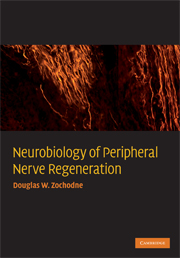Book contents
- Frontmatter
- Contents
- Acknowledgments
- 1 Introduction
- 2 The intact peripheral nerve tree
- 3 Injuries to peripheral nerves
- 4 Addressing nerve regeneration
- 5 Early regenerative events
- 6 Consolidation and maturation of regeneration
- 7 Regeneration and the vasa nervorum
- 8 Delayed reinnervation
- 9 Trophic factors and peripheral nerves
- 10 The nerve microenvironment
- References
- Index
- Plate section
- References
5 - Early regenerative events
- Frontmatter
- Contents
- Acknowledgments
- 1 Introduction
- 2 The intact peripheral nerve tree
- 3 Injuries to peripheral nerves
- 4 Addressing nerve regeneration
- 5 Early regenerative events
- 6 Consolidation and maturation of regeneration
- 7 Regeneration and the vasa nervorum
- 8 Delayed reinnervation
- 9 Trophic factors and peripheral nerves
- 10 The nerve microenvironment
- References
- Index
- Plate section
- References
Summary
In this chapter I discuss the earliest events of peripheral nerve regeneration. What will emerge from this information is a remarkable panoply of cells and molecules that come together for regrowth to occur. Considered separately, the anatomical events, the signaling interactions, and how they influence each other speak to a coordinated beauty. While the anatomical, or cellular features of early nerve regrowth have been described for many years, the molecular cascades involved are only now being considered. Some of this information, such as growth cone signaling and guidance, has not been examined in the specific situation of peripheral nerve regrowth. Nevertheless, there is strong evidence that it eventually will be identified as important in peripheral neurons as in the experimental and central systems studied to date. Thus, some of the material presented relates to the general neurobiology of the growth cone and axon growth, only summarized here. Seen as the forest, rather than the trees, however, it is a critical part of the peripheral nerve regeneration story.
Early axonal events
Immediate responses to injury
When an axon is physically disrupted, a rapid series of molecular events ensues over the next seconds, minutes, and hours. Injured axons undergo rapid depolarization, generating immediate retrogradely propagated “injury potentials.” These critical signals, perhaps associated with a calcium wave, from distal axon to proximal portions of the neuron, may be the first to initiate a shift in its properties. That is, the neuron begins to relinquish its role as a stable transmitter to one primed for regeneration.
- Type
- Chapter
- Information
- Neurobiology of Peripheral Nerve Regeneration , pp. 85 - 132Publisher: Cambridge University PressPrint publication year: 2008



